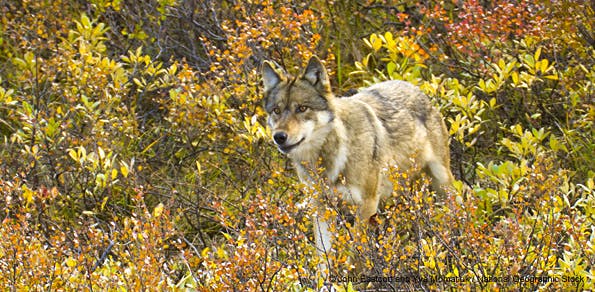Howls heard in California – Oregon’s wandering wolf OR-7 continues to elevate his celebrity status, this time by making the front page of last Sunday’s Sacramento Bee. Environmental reporter Matt Weiser caught wind of OR-7’s travels and talked to Defenders’ wolf expert Suzanne Stone about the potential for wolves in California:
“It’s actually a reason to celebrate,” said Suzanne Asha Stone, Northern Rockies representative for the group Defenders of Wildlife, which led the charge to reintroduce wolves to the West. “I didn’t think I’d see it in my lifetime.”
At this point, OR-7 appears to be staying put in an area 30 miles north of the California border between Medford and Klamath Falls in Oregon. Without a mate, he’s not likely to stick around for long, and it’s anyone’s guess which way he’ll go next. But the fact that Oregon’s wolves are dispersing to new areas is a testament to the success of wolf recovery efforts across the region. And that IS a reason to celebrate!
LA Times exposes darker side of wolf-killing agency – For years, there were rumored to be photographs of a plane used by federal agents of USDA’s Wildlife Services in Idaho, covered with paw prints for every wolf they had killed. This week they finally surfaced. Ken Cole published the photos on his blog, The Wildlife News, in a post titled “The Professionalism of USDA Wildlife Services.” Kim Murphy with the LA Times picked up on it, and the story has since gone viral.
The story emerged just as Idaho is again planning to have aerial gunners target wolves in the Lolo region near Clearwater National Forest. State wildlife officials want to eliminate between 50 and 75 wolves in order to artificially boost elk numbers, which have dropped significantly over the past two decades. Notably, the herd has been in decline since well before wolves were restored to the landscape as a result of multiple factors, including hunting pressure, habitat changes, other predators and use of ATVs. Yet wolves still get most of the blame:
“Unfortunately, it’s become a situation where they’re just scapegoating wolves to try to appease the hunters in the area,” said Suzanne Stone, Idaho representative for Defenders of Wildlife.
With an estimated 103,000 elk in Idaho at the beginning of the fall, compared to about 700 wolves at the end of last year, it’s hard to understand Idaho’s single-minded focus on killing wolves. Meanwhile, hunters and trappers in Idaho have already killed more than 160 wolves with both seasons running through the end of March or later. We have to continue to speak out for wolves and oppose management decisions that allow politics to triumph over biology.
Oregon wolf pack relying too much on livestock –With only 23 confirmed wolves in Oregon, the population still has a long way to go to achieve full recovery. Unfortunately, at least a few wolves from the Imnaha pack in Wallowa County have gotten into the habit of preying on livestock. Imnaha wolves have been implicated in 19 depredations in the past two years, including five since October. Defenders is exploring solutions to prevent further conflict between wolves and livestock.
The good news is that help is on the way from the state, which announced this week that it is ready to roll out its wolf coexistence and livestock compensation program. The $100,000 program will reimburse ranchers for livestock lost to wolves and offer grants for preventative measures to minimize the risk of predation.
Wyoming wolf rider dropped from budget bill – It appears wolves in Wyoming dodged a bullet in this year’s must-pass budget bill for the federal government. A pernicious rider that would have barred legal challenge to the delisting of wolves in Wyoming has been taken off the negotiation table…at least for now. The omnibus funding bill still has to be finalized and signed by the President, but we should all be able to breathe a sigh of relief until next year. Now if the feds could only get Wyoming to adopt a decent wolf management plan…
Good reading – For most of us, wolf conservation is an abstraction, an ideal that we advocate for based on principles of stewardship and concern for the integrity of the natural environment. But for biologists at Yellowstone National Park, wolf conservation is a very different thing. It’s backcountry skiing, peering through binoculars, inspecting elk carcasses, and collecting data—lots and lots of data. In fact, park biologists are the source of much our knowledge about wolves and how they fit into the broader ecosystem, which is why their work is so important. Carly Flandro’s story this week in the Bozeman Chronicle gives us a rare glimpse inside the world of some of those researchers.
For more biting commentary, don’t miss author Marty Essen’s op-ed in the Missoulian debunking persistent wolf mythology. On the heels of a decision by Montana Fish, Wildlife and Parks to extend their wolf hunting season, he says that wolf hysteria is making it dangerous for people and their pets to enjoy the outdoors.





